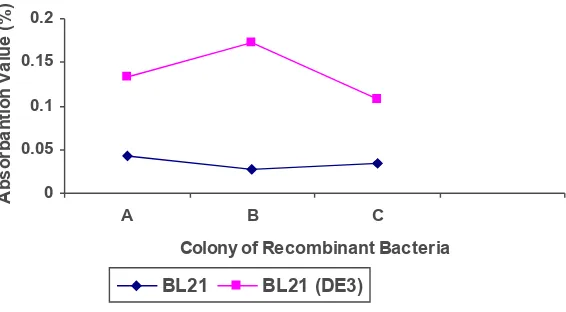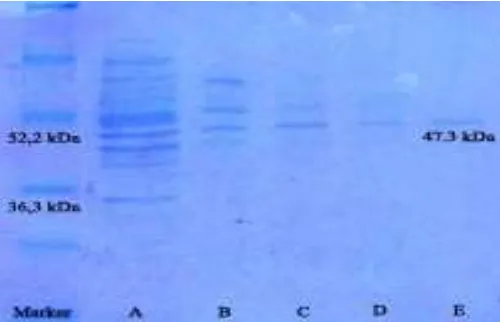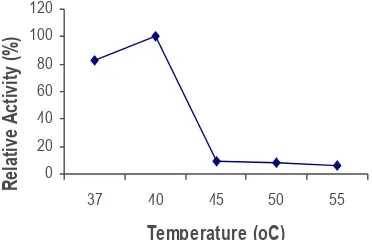PRODUCTION AND CHARACTERIZATION OF CRUDE INTRACELLULER
PHYTASE FROM RECOMBINANT BACTERIA pEAS1AMP
A. M. P. Nuhriawangsa1, Z. Bachruddin2, Sajidan3 and A. Wibowo2
1Laboratory of Processing and Technology Animal Production,
Study Program of Animal Science, Faculty of Agriculture, Sebelas Maret University, Jl. Ir. Sutami No. 36-A Kentingan, Surakarta, Central Java-Indonesia
2Departement of Biochemistry and Nutrition, Study Program of Industry and Animal Science, Faculty of Animal Science, Gadjah Mada University, Jl. Fauna No. 3 Karangmalang, Yogyakarta 55281-Indonesia
3Laboratory of Biotechnology, Study Program of Biology,
Faculty of Teaching and Educating, Sebelas Maret University, Jl. Ir. Sutami No. 36-A Kentingan, Surakarta, Central Java-Indonesia
Corresponding E-mail: [email protected]
Received November 3, 2009; Accepted November 26, 2009
ABSTRACT
This research was aimed at producing a crude intracellular phytase characterized from recombinant bacteria. The recombinant bacteria (pEAS1AMP) was produced by way of transforming pET-22b(+) +pEAS1 into competent E. coli BL21 and E. coli BL21(DE3) cells. Crude intracellular phytase production was induced using 1,5 mM Isopropyl-β-D-thiogalactopyranosid (IPTG). Recombinant bacteria product and enzyme activity test followed the Sajidan method. E. coliBL21(+)pEAS1 and E. coli BL21 (DE3)(+)pEAS1 recombinant bacteria showed growth after 20 hours and 10 hours of transformation. Phytase activity of E. coli BL21 (DE3)(+)+pEAS1 showed higher than those of E. coli BL21(+)+pEAS1. Crude intracellular phytase of pEAS1AMP recombinant bacteria has an optimum activity at pH 5, 40oC, incubation period of 60 minutes, substrate concentration of 2%, molecular weight
(MW) of 47.3 kDa, Km = 15.91 υM and Vm = 2.41 υM/second. Mg2+ acts as a cofactor but Fe3+ (10-4
M) acts as an inhibitor.
Keywords: bacteria recombinant pEAS1AMP, competent cells, crude intracellular phytase
INTRODUCTION
Commercial poultry feed uses P from inorganic P. However, it is now known that the usage of P inorganic produces non digestible P and thus is excreted into the feces. The rapid growth of poultry production has resulted in the increase of pollutant which in turn increases eutrofication. Organic P sources needs to be developed as an alternative source of P for poultry feeds. Organic P is much easier to be digested by poultry animals and reduce the occurance of eutrofication. Phytase can reduce pollution caused by inorganic P, thus eutrofication on water surfaces can be prevented (Pen et al., 1993, Volfova et al., 1994, Shin et al., 2001).
Poultry feed produced from plants (grain) is mostly comprised of agriculture waste products. About two-thirds of plant derived phosphor (P) is in the form of phytate. Phytate is a phosphate
complex, in plants it is stored in the seeds (Reddy et al., 1989). Phytase in categorized in the phosphatase enzyme group and has the ability to hydrolyze phytate compounds (Greiner et al., 1997).
According to Phillippy dan Mullaney (1997), wild type microbes produces lower amounts of phytase when compared to recombinant microbes and recombinant microbes has produced phytase more effectively on large scale production. Phytase that was produced from recombinant bacteria showed specific activity about 1000 times higher than those produced from wild-type bacteria, futhermore, recombinant phytase has the ability to hydrolyze phytate compound up to Inositol (2) monophosphate and was also able to degrade other organic and inorganic phosphates.
stable gene utilizing a recombinant DNA on vector plasmid pET, thus, it was able to effectively code target proteins for the continuity of cell growth.
Environmentally friendly organic P sources derived from agricultural waste products must be developed. Agricultural wastes containing phytic acid can be hydrolyzed by phytase resulting inorganic phytase. Before phytase can be utilized to hydrolyze agricultural wastes, it needs to be produced and characterized. The capability of production and characterization of recombinant bacteria phytase utilizing gene transformation of vector plasmid pET-22b(+)+pEAS1 into E. coli BL21/DE3 was a fascinating subject investigate.
MATERIALS AND METHODS
The study used pET22b(+)-Plasmid-Vector (Novagen 69744-3) with phytase gene EAS1
(AS23[front:1-27]:5’atgcaagacatcaggggctgttacgcc3’ and AS22[behind:1.257-1.233]:5’cggcaggaccatggctaccgccgg3’),
set of competent cells BL21 (Novagen 70232-3) LB media, SOC (Super Optimum Reppresive Catabolic) media, IPTG/ Isopropyl-β-D-thiogalactopyranoside (Promega V395D), Na-phytat (EMerck), Na-acetate (EMerck) dan STOP solution.
Phytase production via over expression of phytase recombinant gene
Phytase gene fragment produced from PCR has been successfully cloned into pET22b(+)-Plasmid-Vector (Novagen 69744-3) using phytase gene (EAS1) with His-Tag sequence on C-terminal. Plasmid vector-insert will be transformed into competent E. coli BL21/(DE3) mixture was then incubated for 90 second at 42oC
and quickly resubmerged in the ice-bath. 2 ml of SOC liquid medium was then added and followed with 2 hours of incubation in a shaker at 37oC and
Enzyme production was produced by Sajidan
method (2002) with modification. Enzyme production starts with collecting one recombinant colony and planting in 5 ml LB media containing amphycillin (25 µg/ml) and incubated on a shaker at 37oC and 100 rpm at 8 hours. 200 µl
liquid media contaning recombinant bacteria was taken and inserted into 9.8 ml LB media containing amphycillin 25 µg/ml, after 90 minutes 10 υl 1 mM IPTG was added to induce enzyme production. Culture was cultivated after one night and centrifuged at 4500 G for 10 minutes at 4oC.
Intracellular enzyme was extracted by extracted the pellet extracted from the crude enzyme. 100mM Na-acetate pH 5 was added to the pellet with a ration of pellet : buffer = 1 : 1 and stored in a -80 oC freezer for 10 minutes then thawed for 20
minutes, this process was replicated twice. Then the mixture was centrifuged at 10,000 G at 4oC
for 30 minutes. Supernatant was collected as a source of crude intracellular phytase.
Measuring recombinant phytase activity
Activity of the resulting recombinant phytase was measured. Measurement was conducted following the Sajidan method (2002): 50 µl enzyme, 150 µl substrate (0.4 % Na-phytate in 100 mM Na-acetat pH 5) incubated at 37°C for 60 minutes. The reaction was stopped using 400 µl STOP solution. The yellow color emitted by Phytase characterization examined its activity against N-phytate at various pH, temperature, incubation period, substrate concentration [S], and metallic ions (concentration 10-3 M and 10-4M)
(Greiner et al., 1997; Sajidan, 2002).
Km and Vm values were revealed using Robyt and White method (1997) by comparing the product before and after hydrolysis (observation period of 30 and 60 minutes) using the Lineweaver-Burk graph approach. Concentration determination used a standard graphic from an organic P source (KHPO4).
(52.2 kDa). Molecular characterization was carried out using SDS-PAGE with 12% polyacrylamid gel and 20 ul sample buffer.
Statistical Analysis
Result of the research was statistically analyzed using descriptive quantitative approach by incorporating observation and count results (Steel and Torrie, 1993).
RESULTS AND DISCUSSIONS
Transformation results of pET22b(+) +pEAS1 into competent cells E. coli BL21 and E. coli BL21 (DE3) after incubation showed the development of recombinant bacteria colony after 20 hours and 10 hours. Plasmid pET22b(+) contains resistant gene against amphicillin up to a dosage of 100 υg/ml. Gene EAS1 of Klebsiella pneumonia was inserted into pET22b(+), resulting in vector plasmid pET22B(+)+pEAS1 formation which will be referred to as pEAS1 (Sajidan, 2002). Transformation utilizing competent cell E. coli BL21/(DE3) was given freezer shock to insert plasmid pET22b(+) +pEAS1, resulting in the production of recombinant bacteria resistant to amphicillin and was able to produce phytase. This research showed that recombinant bacteria E. coli BL21+pEAS1 and E. coli BL21 (DE3)(+)+pEAS1 can grow on LB/Amp 50 υg/ml media. It indicates that plasmid pEAS1 can be transformed into competent E. coli BL21/(DE3)cells.
Transformation of vector plasmid into
competent cells can be utilized as an expression mean to produce phytase. This is inline with the opinion of Lassen et al. (2001) who also expressed phytase genes from Peniophora lycii, Agrocybe pediades, Ceriporia sp. and Trametes pubescens into Aspergillus oryzae, resulting in the production of pure characterized enzymes. Koul et al. (2000) was also able to express DNA genes from Mycobacterium tuberculosis H37Rv into E.
coli to produce tyrosine phosphatase. Golovan et al. (2000) has achieved overproduction by taking advantage of gene appA expressed into E. coli. Han et al. (1999) was able to express phyA from Aspergillus niger gene into Saccharomyces cerevisiae resulting in a positive activity.
Results of measuring the crude extracellular enzyme activity from recombinant bacteria E. coli BL21(+)+pEAS1 and BL21(DE3)(+)+pEAS1 is shown on Figure 1. Results showed that recombinant bacteria E. coli BL21(DE3)(+) +pEAS1 possess a relatively better activity than E. coli BL21(+)+pEAS1. E. coli BL21 (DE3) has a regulator which binds to vector plasmid.
Phytase is a monomer of protein, so its existance of protein (phytase) positioned between MW 36.3 and 52.2 kDa (47.3 kDa), this showed a difference compared to other research findings, but its MW range is correct. The MW range of phytase is between 40 to 100 kDA (Pandey et al., 2001). Gene mptpA and mptpB gene from
Mycobacterium tuberculosis has MW of 56 and 59 kDa (Koul et al., 2000). Gene appA and agp gene from E. coli has MW of 46 dan 45 kDa (Golovan et al., 2000). Gene phyC from B. substilis gene has MW of 43 kDa (Kerovuo et al., 1998).
Results (Figure 3) showed that phytase has an optimum at pH 5. The optimum pH of phytase is within the range of 3,5, to 6 (Greiner and Konietzny, 2006). Native phytase on E. coli has an optimum pH of 4 and Klebsiella pneumonia is very active at pH 5 (Sajidan et al., 2005). Phytase from E. coli BL21 (DE3)(+)pET-appA has an optimum pH of 4.5 (Golovan et al., 2000). Crude phytase (Nuhriawangsa et al., 2008a) and pure
(Nuhriawangsa et al., 2008b) extracellular from recombinant bacteria pEAS1AMP has an optimum activity at pH 5.
Results (Figure 4) showed that phytase has an optimum temperature at 40oC. Hydrolisis
activity of phytase is at the range of 35 to 80oC
(Greiner and Konietzny, 2006). Temperature optimization of native phytase E. coli is at 50-55 °C dan K. pneumonia phytase at 45-50°C (Sajidan et al., 2005). E. coli BL21 (DE3) (+) pET-appA has an optimum temperature range of 55 to 60oC (Golovan et al., 2000). Pure and crude
extracellular phytase from recombinant bacteria pEAS1AMP has an optimum temperature of 45oC
(Nuhriawangsa et al., 2008b) and 40oC
Figure 2. SDS-PAGE 12% MW crude phytase and pure intracellular from recombinant bacteria. M: Marker, A: crude intracellular phytase, B: imidazole 10 mM, C: imidazole 50 mM, D: imidazole 100 mM, E: pure intracellular phytase (imidazole 200 mM)
Figure 3. Relative activity value optimized pH of phytase
0 20 40 60 80 100 120
4 5 6 7
pH
R
e
la
ti
v
e
A
c
ti
v
it
y
(
%
(Nuhriawangsa et al., 2008a).
Results (Figure 5) showed that incubation time of phytase has an optimum at 60 minutes. Enzyme activity increased with the increasing of incubation time. Thus, enzyme activity had maximum when the speed of active bound maximum to product P from S (Nelson dan Cox, 2000). Crude phytase (Nuhriawangsa et al., 2008a) and pure phytase (Nuhriawangsa et al., 2008b) from recombinant bacteria pEAS1AMP has an optimum incubation time at 60 minutes.
[S] had relative activity that was maximum on 2% (Figure 6). Speed of enzyme activity increased when active site of enzyme to bind substrat was increased. Its constant while active site of enzyme was saturated substrat. That
Figure 7. Enzyme had specific character catalytic activity. Catalytic enzyme was arranged by ion or molecule (Rahayu, 1991). Characteristics of ion were influenced by the activity of enzyme, It inhibitor or activator (Nelson dan Cox, 2000).
Result showed that phytase activity was
extracellular phytase from recombinant bacteria pEAS1AMP has activator Mg2+ (10-3 and 10-4 M)
but, It has inhibitor Fe3+ (10-4 M) (Nuhriawangsa
Figure 5. Relative activity value from incubation time of phytase (minutes)
Figure 6. Relative activity from substrat concentration of phytic acid (%)
Figure 4. Relative activity value optimized
temperature (oC) of phytase
Figure 7. Relative activity value about
et al., 2008a).
Definition of Km is specific [S] on ½ Vm (Nelson and Cox, 2000). Result of Km and Vm were calculated by Lineweaver-Burk Curve (Figure 8) that were 15.91 υM and 2.41 υM/ minutes. Value of Km was different from another research, but It was on average of phytase Km value. Fungal phytase has average Km value at 10.6 to 23,2 υM Wyss et al. (1999). Klebsiella sp. had Km value at 280 υM (Sajidan et al., 2004), and recombinant bacteria E. coli BL21 (DE3)pLysSpET-29a(+)-phyA at 96 υM (Philippy dan Mullaney, 1997). Crude extracellular phytase from recombinant bacteria pEAS1AMP has Km and Vm value at 12.33 υM and 1.37 υM/second (Nuhriawangsa et al., 2008a). Pure extracellular phytase from recombinant bacteria pEAS1AMP has Km and Vm value at 54.82 υM and 30.3 υM/ minutes (Nuhriawangsa et al., 2008b).
CONCLUSION
Recombinant phytase was produced by transformation pET-22b(+)+pEAS1 plasmid into competent cells E. coli BL21 and E. coli BL21 (DE3). Relative activity phytase of recombinant bacteria E. coli BL21+pEAS1 was lower than thse of E. coli BL21 (DE3)+pEAS1. Crude intracellular phytase from recombinant bacteria pEAS1AMP had optimum activity at pH 5, temperature 40oC, incubation time 60 minutes,
substrat concentration 2%, molecule weight 47.3 kDa, Km 15.91 υM and Vm = 2.41 υM/second. Mg2+ was cofactor but Fe3+ (10-4 M) was inhibitor.
IMPLICATIONS
Phytase from pEAS1AMP recombinant
bacteria is used to poultry feeding. It is mixed on feed to produce P organic, so feces which is produced will be safe for the environment.
ACKNOLEDGEMENT
We thanks to Director of DP2M DIKTI Department of National Education, Republic of Indonesia for this research fund (Contract number: 035/SP2H/PP/DP2M/III/2007, March 29st 2007).
REFERENCES
BioRad. 2000. Mini-ProteanR II Dual Slab Cell: Instruction Manual. BioRad Laboratories, Harbour Way South, Richmond, CA.
Golovan, S., G. Wang, J. Zhang dan C. W. Forsberg. 2000. Characterization and overproduction of the E. coli appA encoded bifunctional enzyme that exhibits both phytase and acid phosphatase activities. J. Can. Microbiol. 46:59-71.
Greiner, R., E. Haller, U. Konietzny, and K.D. Jany. 1997. Purification and characterization of a phytase from Klebsiella terrigena. Arch. Biochem. Biophys. 341: 201-206.
Greiner R and Konietzny U. 2006. Phytase for food application. J. Food. Technol. Biotechnology 44(2): 125-140.
Han, Y., D. B. Wilson and X. G. Lei. 1999. Expression of an Aspergillus niger phytase gen (phyA) in Saccharomyces cerevisiae. J. App. Enviro. Microbiol. 65(5):1915-1918. Kerovuo, J., M. Lauraeus, P. Nurminen, N.
Kalkkinen and J. Apajalahti. 1998. Isolation, characterization, molecular gene cloning, and sequencing of a novel phytase from Bacillus subtilis. J. App. Enviro.Microbiol. Figure 8. Lineweaver-Burk Curve for determination of Km
64(6):2079-2085.
Koul, A., A. Choidas, M. Treder, A. K. Tyagi, K. Drlica, Y. Singh and A. Ullrich. 2000. Cloning and characterization of secretory tyrosine phosphatases of Mycobacterium tuberculosis. J. American Society Microbiol. 182(19):5425-5432.
Lassen, S. F., J. Breinholt, P. R. Ostergaard, R. Brugger, A. Bischoff, M. Wyss and C. Fuglsang. 2001. Ezpression, gene cloning, and characterization of five novel phytase from our basidiomycete fungi: Peniophora lycii, Agrocybe pediades, a Ceriporia sp., and Trametes pubescens. J. App. Enviro. Microbiol. 67(10):4701-4707.
Nuhriawangsa, A. M. P., Z. Bachruddin,
Sajidan dan A. Wibowo, 2008a.
Karakterisasi
Fitase
Kasar
(Ekstraseluler) dari Bakteri Rekombinan
E. coli BL21 (DE3)+pEAS1. Jurnal
Media Kedokteran Hewan, Fakultas
Kedokteran Hewan UNAIR, Surabaya.
Vol. 24 (2):124-131.
Nuhriawangsa, A. M. P., Z. Bachruddin, Sajidan dan A. Wibowo, 2008b. Produksi dan Karakterisasi Fitase Murni (Ekstraseluler) dari Bakteri Rekombinan E. coli BL21 (DE3)+pEAS1. Dalam: Proseding Seminar Nasional Dies Natalis Fapet UGM ke-39, Yogyakarta. Hal: 44-50.
Pandey, A., G. Szakacs, C. R. Soccol, J. A. Rodriguez-Leon and V. T. Soccol, 2001. Production, purification and properties of microbial phytases. J. Bioresource Tech. 77:203-2014.
Pen, J., T. C. Verwoerd, P. A. VanParidon, R. F. Beudeker, P. J. M. Van den Elzen, K. Geerse, J. D. Van der Klis, H. A. J. Versteegh, A. J. J. Van Ooyen, and A. Hoekema, 1993. Phytase-containing transgenic seeds as novel feed additive for improved fosforous utilization.
Bio. Tech. 11:811 – 814.
Phillippy, B. Q. and E. J. Mullaney, 1997. Expression of an Aspergillus niger Phytase (phyA) in E. coli. J. American Chemical Society. 45:3337-3342.
Reddy, N.R., M.D. Pierson, S.K. Sathe and D.K. Salunkhe, 1989. Phytases in cereals and legumes. CRC Press. Inc. Boca Raton. Fla.
Robyt, J. F. and B. J. White, 1997. Biochemical Tecniques Theory and Practice. Brooks/Cole Pub. Co., Monterey, California.
Sajidan. 2002. Molekulare Characterisierung einer Phytase (Myo-inositol Hexakifosfate Hydrolase) und von Fosfatasen aus Bakterieisolaten Indoneschicher Reisfelder (Klebsiella pneumoniae). Dissertation. Institut fuer Biologie. Humboldt Universitat zu Berlin. Deutschland (Germany).
Sajidan, A. Farouk, R. Greiner, P.Jungbult, Eva-Christina Muller and R. Borris, 2004. Molecular and phycological characterization of a3-phytase from the bacterium Klebsiella pneumonia ASR1. J. App. Mycrobiol. and Biotech. 65:110-118.
Sajidan, A. M. P. Nuhriawangsa dan A. Ratriyanto, 2005. Aplikasi Eschericia coli dan Klebsiella pneumoniae Penghasil Fitase dan Kombinasinya pada Pakan Campuran Wheat Pollard terhadap Performan Ayam Broiler. Dalam: Proseding Seminar Nasional Pengembangan Usaha Peternakan Berdaya Saing di Lahan Kering. Dalam Rangka Dies Natalis UGM, Yogyakarta. Bulan Nopember 2004:186-192.



